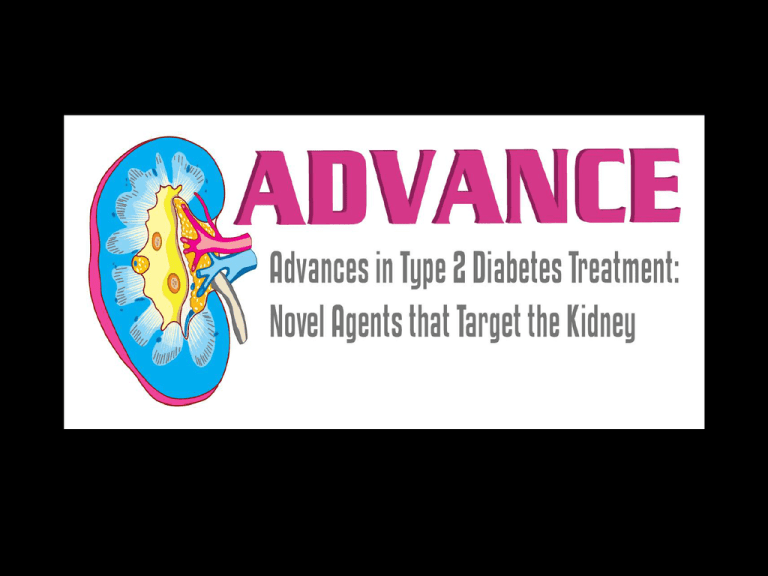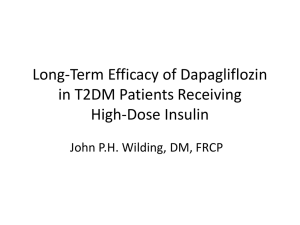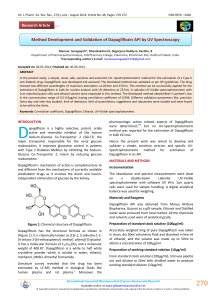2011 US Diabetes Statistics
advertisement

2011 US Diabetes Statistics • Diabetes affects 25.8 million people in the US (8.3% of the U.S. population) – 18.8 million diagnosed, 7.0 million undiagnosed • 10.9 million (26.9%) of those aged ≥65 have diabetes • 215,000 people <20 • 79 million US adults >20 years estimated to have had prediabetes in 2010 • 7th leading cause of death in the U.S. www.cdc.gov/diabetes/pubs/pdf/ndfs_2011.pdf Percentage of U.S. Adults With Diagnosed Diabetes 1994 No Data 2000 <4.5% 4.5-5.9% 6.0-7.4% 2009 7.5-8.9% >9.0% www.cdc.gov/diabetes/statistics Cost of Diabetes • Total (direct and indirect) estimated diabetes costs in the US in 2007 = $174 billion – Medical expenses for people with diabetes are more than two times higher than for people without diabetes • A 50 year old with diabetes dies, on average, 6 years earlier than someone without diabetes Emerging Risk Factors Collaboration. NEJM. 2011; www.cdc.gov/diabetes/pubs/pdf/ndfs_2011.pdf Type 2 Diabetes Pathophysiology Inherited/acquired factors Insulin deficiency, inappropriate glucagon secretion1,3 Acquired/genetic factors (obesity)1,2 Insulin resistance1 FFA1-3 Glucose uptake1,2 Production of glucose in the liver1,2 Glucolipotoxicity Decreased Incretin Effect Hyperglycemia1-3 FFA=free fatty acid Type 2 DM1 1Bergenstal RM, et al. Endocrinology. 2001; 2DeFronzo RA. Diabetes. 1988; 3Poitout V, et al. Endocrinology. 2002. Current Therapeutic Targets BRAIN PANCREAS Dopamine Analogs Pramlintide Insulin GLP-1 Agonists DPP-4 Inhibitors Sulfonylureas Pramlintide (α cells only) Meglitinides GI TRACT LIVER Metformin Thiazolidinediones (TZD) MUSCLE/FAT ?? KIDNEY ?? GLP-1 Agonists Alpha Glucosidase Inhibitors Metformin Thiazolidinediones (TZD) Updated ADA/EASD Consensus Algorithm STEP 1 At Diagnosis: Lifestyle + Metformin STEP 2 Tier 1: Well-validated therapies STEP 3 Lifestyle + Metformin + Basal Insulin Lifestyle + Metformin + Intensive Insulin Lifestyle + Metformin + Sulfonylurea Tier 2: Less well-validated therapies Lifestyle + Metformin Lifestyle + Metformin + + Pioglitazone Pioglitazone + No hypoglycemia, Sulfonylurea edema/CHF, bone loss Lifestyle + Metformin + GLP-1 agonist Lifestyle + Metformin + Basal Insulin No hypoglycemia, weight loss, nausea/vomiting Nathan DM, et al. Diabetes Care. 2009. AACE/ACE DIABETES ALGORITHM FOR GLYCEMIC CONTROL American Association of Clinical Endocrinologists. AACE/ACE Diabetes Algorithm for Glycemic Control. Available at https://www.aace.com/publications. Risks of Current Therapies: Weight Gain Hypoglycemia Metformin DPP-4 Inhibitor GLP-1 Agonist SU Glinide TZD AGI Insulin Pramlintide GLP-1 Agonist SU Glinide TZD AGI Insulin Pramlintide Weight Gain Metformin DPP-4 Inhibitor Neutral Benefits Causes The Kidneys Play an Important Role in the Handling of Glucose • Total glucose stored in body • Glucose utilization • Brain • Rest of body • Glucose in Western diet • Renal glucose production (gluconeogenesis + glycogenolysis) • Renal glucose filtration and reabsorption • Urinary glucose ~450 g ~250 g/day ~125 g/day ~125 g/day ~180 g/day ~70 g/day ~180 g/day 0g Wright EM, et al. J Intern Med. 2007. Sodium-Glucose Cotransporters SGLT1 SGLT2 Site Mostly intestine with some kidney Almost exclusively kidney Sugar specificity Glucose or galactose Glucose Affinity for glucose High Km = 0.4 Mm Low Km = 2 Mm Capacity for glucose transport Low High Role Dietary glucose absorption Renal glucose reabsorption Renal glucose reabsorption Lee YJ, et al. Kidney Int Suppl. 2007. Altered Renal Glucose Control in Diabetes • Renal gluconeogenesis is increased in patients with Type 2 DM • Renal contribution to hyperglycemia • 3-fold increase relative to patients without diabetes • Glucose reabsorption • Increased SGLT2 expression and activity in renal epithelial cells from patients with diabetes vs. normoglycemic individuals Marsenic O. Am J Kidney Dis. 2009; Bakris GL, et al. Kidney Int. 2009; Rahmoune H, et al. Diabetes. 2005. Rationale for SGLT2 Inhibitors • The SGLT2 is a glucose transporter responsible for 90% of glucose reabsorption • Selective SGLT2 inhibitors could reduce blood glucose levels due to increased renal excretion of glucose • Mutations in the SGLT2 transporter linked to hereditary renal glycosuria, a relatively benign condition in humans • Selective SGLT2 inhibition would cause urine loss of the calories from glucose (200-300 kcal/day), also potentially leading to weight loss Brooks AM, Thacker SM. Ann Pharmacother. 2009; Nair S, et al. J Clin Endocrinol Metab. 2010. Effects of SGLT2 Inhibitors Inhibition of renal tubular Na+-glucose cotransporter Reversal of hyperglycemia Reduction of “glucotoxicity” Insulin sensitivity in muscle and liver Gluconeogenesis Improved beta cell function Brooks AM, Thacker SM. Ann Pharmacother. 2009; Nair S, et al. J Clin Endocrinol Metab. 2010. SGLT2 Inhibitors in Phase 3 Development • Dapagliflozin • Canagliflozin • Empagliflozin • Ipragliflozin • Tofogliflozin Empagliflozin: Change in A1C Randomized, double-blind, 12 week trial comparing empagliflozin and open-label metformin† Change in A1C (%) 0.2 0 5 mg 10 mg 25 mg Metformin Placebo -0.2 -0.4 -0.6 -0.8 * * * * N = 408 Baseline A1C = 7.9% *P<.001 vs. placebo †500 mg BID for four weeks, then 1000 mg BID or the maximum tolerated dose Ferrannini E, et al. Abstract 877. EASD 2010. Empagliflozin: Change in FPG Change in FPG (mg/dl) Randomized, double-blind, 12 week trial comparing empagliflozin and open-label metformin† 5 0 -5 -10 -15 -20 -25 -30 -35 5 mg 10 mg 25 mg Metformin * * Placebo * * N = 408 *P<.001 vs. placebo †500 mg BID for four weeks, then 1000 mg BID or the maximum tolerated dose Ferrannini E, et al. Abstract 877. EASD 2010. Empagliflozin: Change in Weight Randomized, double-blind, 12 week trial comparing empagliflozin and open-label metformin† Placebo 5 mg 10 mg 25 mg Metformin -0.5 -1 * Change in weight (%) 0 -1.5 -2 -2.5 * * * N = 408 Baseline BMI = 29 kg/m2 *P<.001 vs. placebo †500 mg BID for four weeks, then 1000 mg BID or the maximum tolerated dose Ferrannini E, et al. Abstract 877. EASD 2010. Empagliflozin: Safety Considerations Randomized, double-blind, 12 week trial comparing empagliflozin and open-label metformin† Side effects: – Polyuria (3.3% vs. 0% in placebo), thirst (3.3% vs. 0% in placebo), and nasopharyngitis (2% vs. 1.2% in placebo) were the most frequently reported side effects – UTI 1.2% vs. 1.2% in placebo and 1.3% in metformin Ferrannini E, et al. Abstract 877. EASD 2010. Canagliflozin: Change in A1C Canagliflozin add-on to metformin, double-blind, placebocontrolled, dose-ranging study (Phase 2) Mean Baseline A1C (%) 7.71 8.01 7.81 7.57 7.70 7.71 7.62 Change in A1C (%) 0 -0.2 -0.22% -0.4 -0.6 -0.8 -0.79% -0.76% * * -1 -0.7% -0.74 * -0.92% -0.95% * PBO 50 mg 100 mg 200 mg N = 451 *P<.001 vs. placebo calculated using LS means 300 mg * * 300 mg BID SITA 100 mg Rosenstock J, et al. Abstract 77-OR. ADA 2010. Canagliflozin: Change in FPG Canagliflozin add-on to metformin, double-blind, placebocontrolled, dose-ranging study (Phase 2) 0 Change in FPG (mg/dl) -5 -10 -15 -20 -16.2 -18 * -25 * -25.2 -30 * -35 50 mg 100 mg -32.4 -32.4 * * 200 mg N = 451 Baseline FGP 162 mg/dl) *P<.001 vs. placebo calculated using LS means 300 mg -30.6 * 300 mg BID SITA 100 mg Rosenstock J, et al. Abstract 77-OR. ADA 2010. Canagliflozin: Change in Weight Canagliflozin add-on to metformin, double-blind, placebocontrolled, dose-ranging study (Phase 2) Mean Baseline Weight (kg) 85.5 87.5 87.7 87.7 87.8 86.3 87 Change in weight (%) 0 -0.6% -1 -1.1 -2 -2.3% -3 * -2.6% * -2.7% * -4 PBO 50 mg 100 mg N = 451 Baseline weight 87 kg *P<.01 vs. placebo calculated using LS means 200 mg 300 mg -3.4% -3.4% * * 300 mg BID SITA 100 mg Rosenstock J, et al. Abstract 77-OR. ADA 2010. Canagliflozin: Safety Considerations Canagliflozin add-on to metformin, double-blind, placebocontrolled, dose-ranging study (Phase 2) Side effects: – Mild-to-moderate, transient – Non dose-dependent increase in symptomatic genital infections: 3-8% in canagliflozin vs. 2% in placebo and 2% in sitagliptin – UTI: 3-9% in canagliflozin (no dose-dependency) vs. 6% in placebo and 2% in sitagliptin – Hypoglycemia: 0-6% in canagliflozin (no dose dependency) vs. 2% in placebo and 5% in sitagliptin Rosenstock J, et al. Abstract 77-OR. ADA 2010. Effects of Canagliflozin on Vulvovaginal Candida Colonization (VCC) – Relative to PBO/SITA, CANA treatment increased conversion to positive vaginal Candida culture and VVC events – Incidence of VVC in female subjects was 2.9% and 3.7% with PBO and SITA, respectively, and 10.4% with CANA – None of the VVC events were serious or led to discontinuation; most were treated with topical or oral antifungals, and resolved without study drug interruption Nyirjesy P, et al. Abstract 0032-LB. ADA 2011. Bacteria or UTI Incidence with Canagliflozin – At Week 12, CANA decreased A1C (0.45%-0.73% relative to PBO), lowered weight (1.3%-2.3% relative to PBO), and increased urinary glucose excretion (UGE) (35.4-61.6 mg/mg creatinine) – Conversion from negative baseline urine bacterial culture to positive culture did not differ in pooled CANA group vs pooled PBO/SITA group (4.8% vs. 3.7%, respectively) – UTI AEs (both symptomatic and positive post-baseline urine culture reported as a UTI) occurred in 16 (5.0%) in pooled CANA group and 5 (3.8%) in pooled PBO/SITA group – All UTI AEs considered mild or moderate, and none led to discontinuation Nicolle L, et al. Abstract 0043-LB. ADA 2011. Dapagliflozin Phase 3 Studies: Change in A1C Placebo Dapa 2.5mg Dapa 5mg Dapa 10mg 0 -0.1 Change in A1C (%) -0.2 -0.3 -0.4 -0.5 Monotherapy Met add-on SU add-on Insulin add-on -0.6 -0.7 -0.8 -0.9 -1 BaselineMonotherapy (N=591): 8.6% Met add-on (N=546): 8% SU add-on (N=597): 8.1% Insulin add-on (N=808): 8.5% Wilding JPH, et al. Abstract 871. EASD 2010; Strojek K, et al. Abstract 870. EASD 2010; Ferrannini E, et al. Diabetes Care. 2010; Bailey CJ, et al. Lancet. 2010. Dapagliflozin Phase 3 Studies: Change in FPG Placebo 5 Dapa 2.5mg Dapa 5mg Dapa 10mg Change in FPG (mg/dl) 0 -5 -10 Monotherapy -15 Met add-on -20 Insulin add-on -25 -30 -35 BaselineMonotherapy (N=591): 179 mg/dl Met add-on (N=546): 163.9 mg/dl Insulin add-on (N=808): 178 mg/dl Wilding JPH, et al. Abstract 871. EASD 2010; Ferrannini E, et al. Diabetes Care. 2010; Bailey CJ, et al. Lancet. 2010. Dapagliflozin Phase 3 Studies: Change in Weight 0.5 Placebo 0 Dapa 2.5mg Dapa 5mg Dapa 10mg Change in weight (kg) -0.5 -1 -1.5 -2 Monotherapy Met add-on SU add-on Insulin add-on -2.5 -3 -3.5 BaselineMonotherapy (N=591): 89.7 kg Met add-on (N=546): 85.9 kg SU add-on (N=597): 81.1 kg Insulin add-on (N=808): 94 kg Wilding JPH, et al. Abstract 871. EASD 2010; Strojek K, et al. Abstract 870. EASD 2010; Ferrannini E, et al. Diabetes Care. 2010; Bailey CJ, et al. Lancet. 2010. Dapagliflozin, Metformin XR, or Both as Initial Therapy 0 -1 M E T D A P A D A P A 5 m g + M E T M E T D A P A 1 0 m g D A P A + M E T 0 -20 -40 -2 -3 M E T D A P A D A P A 5 m g + M E T D A P A 1 0 m g M E T D A P A + M E T -60 -80 Change in A1C 0 -1 -2 M E T D A P A D A P A 5 m g + M E T M E T Change in FPG D A P A D A P A 1 0 m g + M E T -3 -4 Change in Body Weight Henry R, et al. Abstract 307-OR. ADA 2011. Dapagliflozin: Effect on BP and Lipids Systolic Blood Pressure (mmHg) – Placebo: -0.2 – Dapa 2.5mg: -2.1 – Dapa 5mg: -4.3 – Dapa 10mg: -5.1 HDL (% change) – Placebo: +0.4 – Dapa 2.5mg: +1.8 – Dapa 5mg: +3.3 – Dapa 10mg: +4.4 Diastolic Blood Pressure (mmHg) – Placebo: -0.1 – Dapa 2.5mg: -1.8 – Dapa 5mg: -2.5 – Dapa 10mg: -1.8 Triglycerides (% change) – Placebo: +2.1 – Dapa 2.5mg: -2.4 – Dapa 5mg: -6.2 – Dapa 10mg: -6.2 Bailey CJ, et al. Lancet. 2010. Dapagliflozin: Safety Considerations Based on all trials (Monotherapy, metformin add-on, sulfonylurea add-on, and insulin add-on) Side effects: – UTI*: 3.9-13.2% in dapagliflozin vs. 4-6.2% in placebo1-3 – Genital infections*: 3.9-12.9% in dapagliflozin vs. 0.7-5% in placebo1-4 – Hypoglycemia: 0-7.9% in dapagliflozin vs. 2.7-4.8% in placebo2-4 *Most occurred during the first 24 weeks, were generally mild, and responded to routine management 1Wilding JPH, et al. Abstract 871. EASD 2010; K, et al. Abstract 870. EASD 2010; 3Ferrannini E, et al. Diabetes Care. 2010; 4Bailey CJ, et al. Lancet. 2010. 2Strojek Dapagliflozin: Sulfonylurea Comparator Study Randomized, double-blind, parallel-group, multicenter trial comparing dapagliflozin to glipizide as add-on to metformin Results • Average A1C: 7.72% • Change in A1C: -0.52% for dapagliflozin vs. -0.52% for glipizide • Weight change: -3.2 kg for dapagliflozin vs. +1.4 kg for glipizide • Hypoglycemic episodes: 3.5% for dapagliflozin vs. 40.8% with glipizide • Significant reductions in diastolic and systolic blood pressure and improvement in HDL with dapagliflozin vs. glipizide (P<.0001) • Side effects: • UTI: 10.8% with dapagliflozin vs. 6.4% with glipizide (actively solicited) • Genital infection: 12.3% with dapagliflozin vs. 2.7% with glipizide (actively solicited) • Renal impairment: 5.9% with dapagliflozin vs. 3.4% with glipizide Nauck MA, et al. Diabetes Care. 2011. Dapagliflozin + Insulin for 48 Weeks • A1C reductions from baseline for PLA and DAPA 2.5, 5, and 10mg at 24 weeks were maintained at 48 weeks – (−0.43%, −0.74%, −0.94%, −0.93%, respectively) • 24 week body weight reductions with DAPA were maintained at 48 weeks – −1.5kg with DAPA 10mg vs. +0.9kg with PLA • AEs, serious AEs, and discontinuations were balanced across all groups • Actively solicited s/sx suggestive of UTI and genital infections (GI) were more with DAPA vs PLA – UTI 7.9%-10.8% vs. 5.1%; GI 6.4%-10.7% vs. 2.5% – most events were reported during the first 24 weeks, were of mild/moderate intensity and responded to standard treatment AE = Adverse events s/sx = signs and symptoms Wilding J, et al. Abstract 0021-LB. ADA 2011. Insulin dose (IU/day) Adjusted mean change from baseline ± SE Dapagliflozin + Insulin for 48 Weeks: Insulin Dose 15 PLA + INS DAPA 2.5 mg + INS DAPA 5 mg + INS DAPA 10 mg + INS 10 5 0 -5 0 4 8 12 16 20 24 28 32 36 40 44 48 Timepoint (weeks) Wilding J, et al. Abstract 0021-LB. ADA 2011. Long-Term Efficacy of Dapagliflozin + Metformin Week 102 Results Adj. Mean ∆ From Baseline PBO+MET DAPA 2.5mg + MET DAPA 5mg + MET DAPA 10mg + MET A1C, % 0.02 -0.48 -0.58 -0.78 FPG, mg/dL -10.4 -19.3 -26.5 -24.5 Weight, kg -0.7 -2.2 -3.4 -2.8 % with ≥1 hypoglycemic event 5.8 3.6 5.1 5.2 Bailey CJ, et al. Abstract 0988-P. ADA 2011. Potential SGLT2 Safety Considerations??? • Evidence Demonstrates • Urinary tract/genital infections • Questions • • • • • Hepatic toxicity? Breast and bladder cancer?? Intravascular volume depletion due to osmotic diuresis?? Nephrotoxicity (AGEs)?? Drug-drug interactions?? • Evidence Does Not Demonstrate • • • Electrolyte imbalance (Na+, K+, Ca++, PO4) Increased risk for hypoglycemia Nocturia Dapagliflozin PDUFA Date The FDA issued a Complete Response Letter to the makers of dapagliflozin on January 19, 2012 requesting additional information. SGLT2 Inhibitors: A New Era in Diabetes Treatment?? • In treatment-naive patients with newly-diagnosed Type 2 DM, SGLT2 inhibitors resulted in: • Clinically meaningful decreases in A1C and fasting plasma glucose with no increased risk of hypoglycemia • Also improved glycemic control in combination with a variety of other antihyperglycemic agents • Metformin, sulfonylureas, insulin • Side effects generally appear to be mild and transient, while avoiding increased risk of hypoglycemia or weight gain









